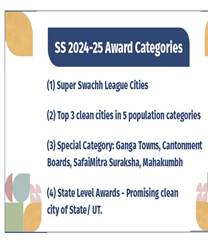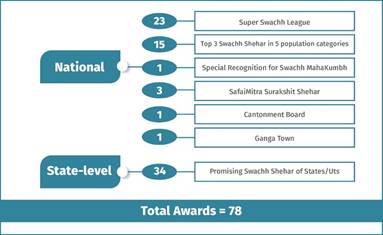On 17th July, 2025, there is a great ceremony to hold the award ceremony for the Swachh Survekshan 2024-25 Awards, which will be conferred by the President of India, Smt. Droupadi Murmu, and this award ceremony is organised by the Ministry of Housing and Urban Affairs (MoHUA) at Vigyan Bhawan, New Delhi, with the presence of Union Minister of Housing and Affairs, Shri Manohar Lal. Swachh Survekshan marks its 9th edition for the survey of cleanliness reports worldwide. In this report, Indore has done it again! For the eighth year in a row, it holds the title of India’s cleanest city. But the real story this year goes beyond just one name. Surat, Navi Mumbai, and several other cities are stepping up big time, proving that urban India is serious about staying clean, healthy, and green. These rankings come from the latest round of Swachh Survekshan 2024-25, the country’s biggest cleanliness survey run by the Ministry of Housing and Urban Affairs. And this time, the process itself got a bit of a makeover.
LIVE: President Droupadi Murmu's address at the Swachh Sarvekshan Awards Ceremony 2024 at Vigyan Bhavan https://t.co/IDSoT3dFKK
— President of India (@rashtrapatibhvn) July 17, 2025

Source: PIB
What’s New in Swachh Survekshan 2024-25?
To keep things fair and highlight the efforts of towns big and small, the government introduced something fresh—the Super Swachh League. In 2024-24, there are 78 awardrs across 4 catyegories has been awarded in 9th edition of Swachh Survekshan. For adoption of Swachh Survekshan smartly, thius edition marks the structured approach for assesment of urban cleanliness and others services by using 10 different parameters. Instead of lumping everyone together, cities were split into five categories based on population size. From tiny towns to bustling megacities, everyone got a fair shot.
The rankings don’t just depend on sweeping streets anymore. They take into account waste management systems, sanitation drives, certifications, ground-level inspections, and even how residents feel about their city’s cleanliness.


Source: PIB
How has Indore consistently maintained its top ranks in the Cleanest Cities in Million Plus Cities of India?
In 2016, Indore was ranked number 25. But from 2016 to 2025, it was the cleanest city in India. Although it took some time to make this adjustment, it was the consequence of persistent effort rather than magic. Strong municipal systems, better waste separation, and individuals who actively participated all functioned as one cohesive unit.
And let’s not forget, Surat and Navi Mumbai are hot on Indore’s heels. They’re not just keeping up; in many areas, they’re setting examples too. All three cities have made it to the top in the “Million Plus Cities” group—those with populations over 10 lakh.
As per PIB, the 9th edition of Swachh Survekshan, the List of 12 Cleanest Cities in India 2024-25, is given below in the table:
Top 12 Cleanest Cities In India (2024–25) | ||
|---|---|---|
| Category | City | State/UT |
| Very Small Cities (< 20,000) | Panchgani | Maharashtra |
| Patan | Gujarat | |
| Small Cities (20,000 – 50,000) | Vita | Maharashtra |
| Sasvad | Maharashtra | |
| Medium Cities (50,000 – 3 lakh) | Ambikapur | Chhattisgarh |
| Tirupati | Andhra Pradesh | |
| NDMC (New Delhi Municipal Council) | Delhi | |
| Big Cities (3–10 lakh) | Noida | Uttar Pradesh |
| Chandigarh | Chandigarh (UT) | |
| Million Plus Cities (>10 lakh) | Indore | Madhya Pradesh |
| Navi Mumbai | Maharashtra | |
| Surat | Gujarat | |
Conclusion
The Swachh Survekshan 2024–25 isn’t just about winners and rankings; rather, it's a reflection of how far we’ve come as a country in rethinking cleanliness. Indore’s seventh consecutive win is certainly worth celebrating, but it’s equally heartening to see so many other cities joining the movement, from megacities like Surat and Navi Mumbai to smaller towns like Panchgani and Ambikapur. Cleanliness of the city is not only a government initiative; in fact, residents are also very active toward the cleanliness of the city. The journey of the cleanest city in every city in India is not so far if, like this, only active participants are involved from both sides, i.e., on the government and public side; then clean, green and liveable cities are no longer a dream.
Comments
All Comments (0)
Join the conversation